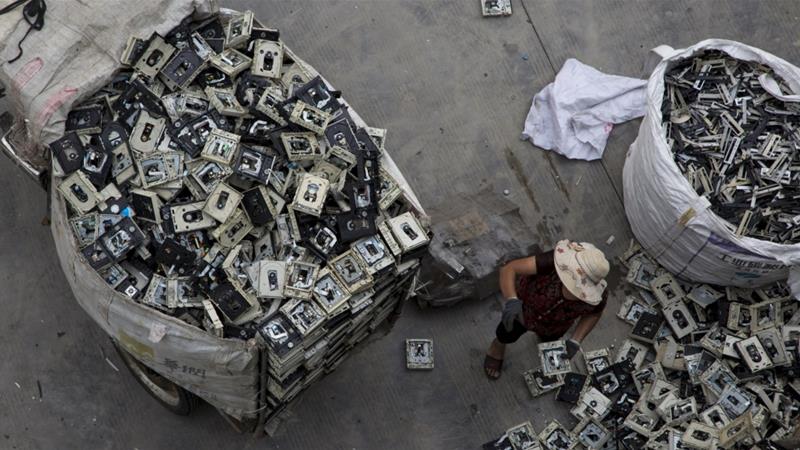How to Tackle the Challenges Posed by Electronic Waste
ENVIRONMENT, 20 Mar 2017
We want to have a creative mind, a critical eye, and a helping hand if we are to find solutions to e-waste challenges.

A worker distributes electronic waste at a government managed recycling centre at the township of Guiyu in China’s southern Guangdong province June 10, 2015. [Reuters]
18 Mar 2017 – Electronic waste, or e-waste, refers to computers, mobile phones and other devices after users have thrown them away.
E-waste has become a new and controversial global challenge. To some e-waste is an environmental scourge to be battled. To others it is an opportunity to enhance economic development.
Let us delve into what makes e-waste special, its dangers and payoffs, how countries are managing it, and how the world might do better.
To set the stage, ownership of electronics has grown explosively, not just in rich countries, but all over the world. This increased ownership, combined with rapid obsolescence, leads to the generation of large amounts of e-waste.
There are three important characteristics of e-waste. Firstly, in many cases, the “waste” is still functional or can be easily repaired. The device has only become redundant to its first owner.
| Moreover, electronic waste contains valuable materials such as copper in wires and gold in circuit boards that make it attractive for recycling. And thirdly, these valuable materials are mixed in a complicated way with other ones, some of which are hazardous or can become hazardous when recycled. |
These three characteristics combine to make the e-waste challenge unique.
Demand for used electronics is higher in developing countries. This demand, combined with high repair and recycling costs in rich countries, imply that e-waste has more economic value in the developing world than the developed. This value difference has led to a booming international trade in e-waste.
Much of the traded “waste” is electronics repaired and resold in the destination countries, providing employment and helping to bridge the digital divide.
There are environmental and human costs, however, from e-waste leftover after repair. An informal sector has emerged that uses destructive processes to recover valuable materials from scrap electronics.
For example, copper in wires is separated from its plastic casing by burning the latter in an open area. The result is emissions violating standards by orders of magnitude.
Gold in circuit boards is recovered using cyanide and nitric acid, the leftover chemicals are often dumped, contaminating local water systems.
Distressing scenes of this informal recycling have become regular fare for the global media. China and Nigeria are often showcased as centres for informal recycling of electronics, but it is actually common in much of the developing world.
Responses to e-waste
How has the world responded to the e-waste challenge? Consider two areas often showcased in the media, China and Nigeria.
Informal recycling of electronics was introduced to the world in 2002 with reports on activities in the Chinese town of Guiyu. Beyond Guiyu, informal collection, repair and recycling of electronics are widespread in China (PDF).
The Chinese government responded by banning imports of e-waste (and used electronics) and informal recycling.
|
The environmental impacts of informal recycling are important and must be addressed. It does not follow, however, that bans are the only way to solve the problem. |
In addition, the government invested heavily in creating a formal recycling sector to process e-waste instead of the informal, including cash incentives to consumers to turn in devices to the formal sector.
Despite these aggressive measures, informal recycling is apparently still common in China. One reason is that enforcement of bans is difficult and expensive.
A second reason is that even with considerable government subsidy, it is hard for the formal sector to compete with the informal because it does not work to derive the main value from e-waste, the potential to be repaired and resold.
Lagos in Nigeria is a known centre for repair, resale and informal recycling of e-waste. The Nigerian government has passed laws banning dumping of waste and the import of e-waste – though functional used electronics can be imported.
| It is difficult to know to what extent these laws have reduced informed recycling and reduced repair and reuse of electronics. |
Towards the future
There are three ways the world could be a better job of tackling the e-waste challenge.
Firstly, we should broaden the scope. Governments have treated e-waste as an environmental challenge to be managed via regulation.
Make no mistake, the environmental impacts of informal recycling are important and must be addressed. It does not follow, however, that bans are the only way to solve the problem.
In addition to mitigating environmental impacts, it is also important to employ people and bridge the digital divide. Workers in the informal sector, the most affected group, need to be consulted in the development of solutions.
Secondly, we should find better ways to measure data and then reduce e-waste generation. There are huge knowledge gaps on e-waste. This is because governments collect very little relevant data.
It is thus important to do much better at measuring e-waste. New information can shift the perspective on the problem.
For example, forecasts of the global generation of e-waste indicate that soon more e-waste will come from the developing world than the developed.
This means that stopping the trade in e-waste cannot solve the problem because domestically generated e-waste would, without intervention, be recycled by the informal sector.
In the quest for better measurement, it is important to distinguish between measurement and hearsay. Numerical “rumours“, without real basis, continue to influence the public discourse on e-waste. This needs to change.
READ MORE: Q&A – E-waste goes to post-recycling afterlife
And finally, we should try new approaches. A new problem calls for new solutions. For example, it may be possible to combine the informal and the formal sector so as to achieve safe recycling while employing people to extract the most value from repairing and reselling electronics.
One approach to realise this is to provide to pass on materials to the formal recycling sector. There are other possible solutions, each has its own challenges. There is a need to develop and pilot new approaches.
There are efforts under way to better measure and manage e-waste, in particular, the Solve the E-waste Problem (SteP) Initiative of the United Nations. More work and support are needed.
By combining a creative mind, a critical eye, and a helping hand, there is potential to realise solutions to e-waste that help people and the planet.
______________________________________
 Eric Williams is associate professor at the Golisano Institute for Sustainability at Rochester Institute of Technology in New York. His research on characterizing and managing electronic waste has been widely cited in the media and in academic journals.
Eric Williams is associate professor at the Golisano Institute for Sustainability at Rochester Institute of Technology in New York. His research on characterizing and managing electronic waste has been widely cited in the media and in academic journals.
Go to Original – aljazeera.com
DISCLAIMER: The statements, views and opinions expressed in pieces republished here are solely those of the authors and do not necessarily represent those of TMS. In accordance with title 17 U.S.C. section 107, this material is distributed without profit to those who have expressed a prior interest in receiving the included information for research and educational purposes. TMS has no affiliation whatsoever with the originator of this article nor is TMS endorsed or sponsored by the originator. “GO TO ORIGINAL” links are provided as a convenience to our readers and allow for verification of authenticity. However, as originating pages are often updated by their originating host sites, the versions posted may not match the versions our readers view when clicking the “GO TO ORIGINAL” links. This site contains copyrighted material the use of which has not always been specifically authorized by the copyright owner. We are making such material available in our efforts to advance understanding of environmental, political, human rights, economic, democracy, scientific, and social justice issues, etc. We believe this constitutes a ‘fair use’ of any such copyrighted material as provided for in section 107 of the US Copyright Law. In accordance with Title 17 U.S.C. Section 107, the material on this site is distributed without profit to those who have expressed a prior interest in receiving the included information for research and educational purposes. For more information go to: http://www.law.cornell.edu/uscode/17/107.shtml. If you wish to use copyrighted material from this site for purposes of your own that go beyond ‘fair use’, you must obtain permission from the copyright owner.